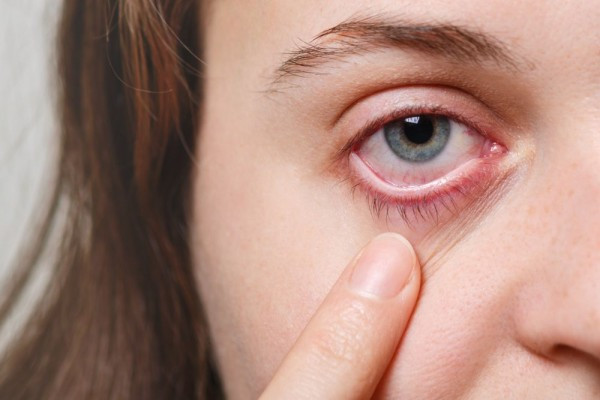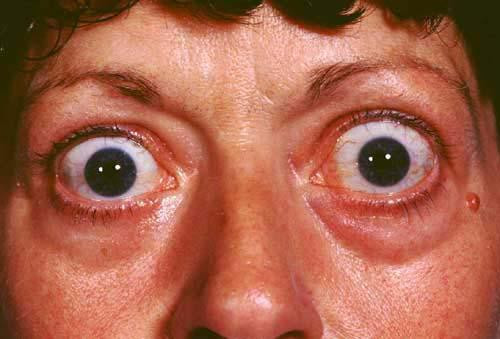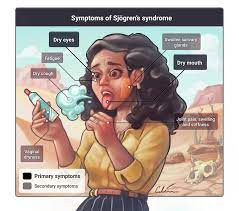Definisi
Xeroftalmia adalah penyakit mata yang ditandai oleh mata kering akibat kekurangan vitamin A. Hingga saat ini, xeroftalmia menjadi salah satu masalah pada negara berkembang dan penyebab utama dari kebutaan yang sebenarnya dapat dicegah. Organisasi Kesehatan Dunia atau WHO menyebutkan sekitar 254 juta anak mengalami kekurangan vitamin A (45% di antaranya terdapat di Asia Selatan dan Asia Tenggara) serta 8 juta anak mengalami xeroftalmia. Setidaknya, terdapat kurang lebih 350.000 kasus baru xeroftalmia setiap tahunnya. Xeroftalmia diketahui tidak hanya menyebabkan kebutaan, tetapi dapat mengganggu pertumbuhan, serta meningkatkan angka kesakitan dan kematian secara umum.
Penyebab
Kekurangan vitamin A merupakan penyebab utama terjadinya xeroftalmia. Vitamin A berperan untuk memberi nutrisi pada mata, termasuk lapisan bening di kornea mata. Apabila terjadi kekurangan vitamin A, pelumas atau cairan bola mata juga akan berkurang dan menyebabkan mata kering.
Vitamin A bisa didapatkan dari makanan yang dikonsumsi karena tubuh tidak dapat memproduksi vitamin A secara mandiri. Manfaatnya pada mata bukan hanya pada kornea saja, tetapi juga dapat membantu cahaya terserap ke dalam retina mata. Selain itu, vitamin A juga penting bagi organ tubuh lainnya, seperti jantung, paru, dan ginjal.
Vitamin A yang kurang di dalam tubuh dapat disebabkan oleh beberapa kondisi. Penyebab tersering adalah asupan vitamin A yang kurang. Namun, penyakit yang menyebabkan gangguan pada metabolisme dan penyimpanan vitamin A juga bisa menjadi penyebab. Penyakit tersebut misalnya kelainan pada hati, seperti penyakit liver kronis, alkoholisme, riwayat operasi saluran cerna atas, penyakit usus iritatif, dan pankreatitis.
Faktor Risiko
Kemiskinan dan pola makan yang kurang bergizi, terutama kurang mengonsumsi produk olahan hewani dapat menjadi faktor risiko terjadinya xeroftalmia. Hal ini berhubungan dengan kurangnya konsumsi makanan dengan kandungan vitamin A.
Vitamin A dibutuhkan anak untuk pertumbuhan dan perkembangan. Biasanya, kekurangan vitamin A dapat memicu berbagai penyakit, seperti diare, campak, dan infeksi paru. Beberapa kondisi lainnya yang dapat menjadi faktor risiko kekurangan vitamin A adalah sebagai berikut:
- Alkoholisme atau penyakit yang disebabkan karena kecanduan alkohol
- Fibrosis kistik
- Penyakit Celiac, di mana dapat menghambat penyerapan nutrisi
- Penyakit liver seperti sirosis hati
- Diare lama/kronik
- Terapi radiasi seperti pada kanker tiroid
Gejala
Xeroftalmia merupakan penyakit yang progresif, artinya gejala awal dapat ringan namun akan bertambah parah apabila asupan vitamin A tidak kunjung terpenuhi. Kondisi tersebut akan dirasakan sebagai gejala mata kering. Beberapa gejala lainnya adalah sebagai berikut:
- Mata terasa gatal
- Mata terasa mengganjal
- Mata terasa pedih
- Mata merah
- Penglihatan kabur
- Lebih sensitif terhadap cahaya
- Rabun senja
Selain gejala di atas, pada xeroftalmia dengan gejala yang lebih berat dapat muncul jaringan kornea mata yang melepuh yang disebut dengan bintik Bitot. Apabila kondisi mata dibiarkan, dapat pula terjadi luka pada kornea mata yang berujung pada ulkus kornea. Hal tersebut cukup berbahaya karena dapat menimbulkan kebutaan.
Diagnosis
Dokter dapat menegakkan diagnosis xeroftalmia dengan melakukan pemeriksaan riwayat gejala, pemeriksaan fisik, dan pemeriksaan penunjang. Dokter akan menanyakan keluhan yang dirasa mengganggu dan terjadi pada mata. Setelah itu, dokter juga akan menggali faktor risiko terutama yang menyebabkan kecurigaan penyebab kekurangan vitamin A.
Setelah melakukan pemeriksaan riwayat gejala, dokter akan melakukan pemeriksaan fisik pada pasien. Pemeriksaan mata dapat meliputi pemeriksaan tajam penglihatan dan struktur mata menggunakan slit lamp. Pada pemeriksaan mata, dapat ditemukan bintik di kornea mata yang merupakan gambaran khas pada xeroftalmia gejala berat, yaitu bintik Bitot.
Untuk memastikan kadar vitamin A pada seseorang, dokter dapat melakukan pemeriksaan darah. Melalui pemeriksaan darah tersebut, dokter dapat menentukan apakah terjadi kekurangan kadar vitamin A atau retinol pada pasien.
Tata Laksana
Pengobatan xeroftalmia pada tahap awal adalah dengan memberikan suplemen vitamin A, baik diminum atau disuntik. Suplemen vitamin A ditujukan untuk menghilangkan gejala rabun senja dan membantu mata kembali memproduksi cairan pelumas mata. Selain suplemen, pasien juga perlu mengonsumsi makanan yang kaya akan vitamin A, seperti:
- Sumber makanan hewani, yaitu hati sapi, ayam, salmon, tuna, makarel, susu, keju, yogurt, dan telur
- Sumber makanan nabati, yaitu bayam, selada, wortel, jeruk, pepaya, dan semangka
Namun, jika xeroftalmia sudah menyebabkan kornea mata rusak, maka dokter dapat memberikan antibiotik untuk mencegah infeksi. Selain itu, mata perlu diistirahatkan atau ditutup sementara hingga benar-benar sembuh. Bila xeroftalmia tidak ditangani dengan tepat, maka dapat terjadi kerusakan saraf dan jaringan mata lebih lanjut hingga menyebabkan kebutaan.
Komplikasi
Xeroftalmia dapat menjadi salah satu penyebab terjadinya luka pada kornea yang disebut dengan ulkus kornea. Pada tahap awal, xeroftalmia yang telah menjadi ulkus kornea, apabila ditangani dengan baik, penglihatan dapat kembali seperti semula. Namun, pada beberapa kasus yang lebih parah, operasi sekali pun tidak dapat mengembalikan penglihatan. Oleh karena itu, komplikasi terberat dari xeroftalmia ini adalah kebutaan permanen.
Pencegahan
Asupan vitamin A yang tercukupi dengan baik merupakan salah satu pencegahan utama untuk xeroftalmia. Asupan vitamin A per hari yang dibutuhkan tergantung dari usia dan jenis kelamin, yaitu:
- Pria dewasa membutuhkan sekitar 3000 unit
- Wanita dewasa membutuhkan sebanyak 2310 unit per hari
- Wanita hamil memerlukan setidaknya 2565 unit vitamin A per hari
- Anak-anak di bawah 13 tahun kebutuhan vitamin A per harinya adalah 2000 unit
- Anak di bawah 8 tahun kebutuhannya adalah 1320 unit
- Anak usia 1-3 tahun membutuhkan 1000 unit per hari
Pada anak-anak, terdapat program pemerintah setiap 6 bulan sekali terkait suplementasi vitamin A. Oleh karena itu, salah satu upaya untuk mencegah terjadinya xeroftalmi pada anak adalah dengan rutin membawa anak usia 0-5 tahun ke posyandu secara rutin, terutama saat jadwal pemberian suplementasi vitamin A tersebut.
Bagi seseorang yang memiliki penyakit yang mengganggu penyerapan vitamin A, seperti pada pecandu alkohol (alkoholisme), fibrosis kistik, dan sirosis hati, maka asupan vitamin A perlu disesuaikan dengan anjuran dokter. Biasanya, dibutuhkan jumlah vitamin A yang lebih tinggi dibandingkan orang dewasa sehat.
Kapan Harus ke Dokter?
Periksakan ke dokter apabila Anda merasakan gejala yang mengarah ke xeroftalmia. Gejala paling umum yang dapat dirasakan adalah adanya mata kering dan kesulitan melihat dengan jelas, terutama pada malam hari atau cahaya redup.
Apabila gejala dirasakan pada anak, segera bawa ke dokter mata. Pada anak yang sedang terkena campak juga berisiko terjadi xeroftalmia. Oleh karena itu, bila anak Anda muncul gejala campak, seperti adanya ruam pada kulit dan demam, jangan ragu untuk membawa ke dokter terdekat. Dokter akan melakukan pemeriksaan menyeluruh, sehingga risiko terjadinya xeroftalmia pun dapat dicegah.
Mau tahu lebih lanjut seputar penyakit-penyakit lainnya? Cek di sini, ya!
- dr Ayu Munawaroh, MKK
Bowling, B. Kanski’s clinical ophthalmology. Edisi ke-8. Philadelphia: Elsevier. 2016.
Legg, TJ. Everything You Should Know About Xerophthalmia (2017). Available from: https://www.healthline.com/health/eye-health/xerophthalmia.
Feroze, KB., Kaufman, EJ. Xerophthalmia (2021). Available from: https://www.ncbi.nlm.nih.gov/books/NBK431094/.
American Academy of Ophthalmology. Xerophthalmia. Available from: https://eyewiki.aao.org/Xerophthalmia.
World Health Organization. Xerophthalmia and night blindness for the assessment of clinical vitamin A deficiency in individuals and populations. 2014.












